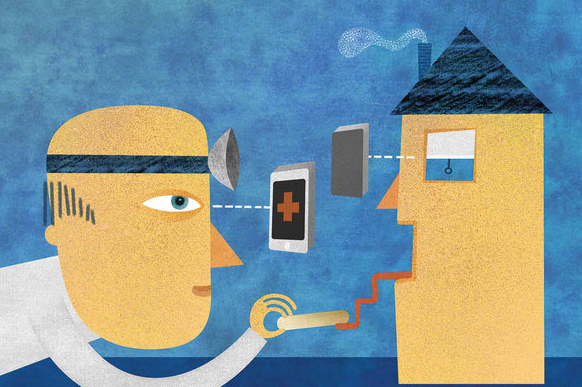New smartphone apps can deliver doctors to your doorstep.
Heal is a smartphone app similar to the on-demand car service Uber, but instead of a car, a doctor shows up at your door. Users download the app and then type in a few details such as address and the reason for the visit. After adding a credit card and a request for a family doctor or a pediatrician, the physician arrives in 20 to 60 minutes for a flat fee of $99. Heal began in Los Angeles in February, recently expanded to San Francisco and is set to roll out in another 15 major cities this year. Heal doctors are on call from 8 a.m. to 8 p.m., seven days a week, said Dr. Renee Dua, a founder and the chief medical officer of Heal.
Heal doctors arrive with a medical assistant and a kit stocked with the latest high-tech health gadgets, including tools needed to take your vitals or shoot high-definition video of your eardrum. Heal has a roster of doctors who have affiliations with respected hospitals and programs such as the University of California, Los Angeles; Columbia; and Stanford. 
“We’re bringing back old-school techniques with new-school technology,” Dr. Dua said.
Obviously, Heal doctors can offer only limited services on a house call. Among other things, they can diagnose and treat moderate ailments like bronchitis, give flu shots, stitch up a nasty cut or write a prescription (they will even pick the prescription up for an extra $19). But you will have to file the insurance paperwork.
“Health really starts in the home,” Dr. Janani Krishnaswami said as we sat at my dining room table in Oakland, Calif., after I had summoned her using the Heal app on my iPhone. “By seeing someone where they live, I can look at what their life is like, what they’re eating, how they’re living, what’s stressing them out. I can take however much time I need with them, which is increasingly difficult to do in our current system of medicine.”
A similar service called Pager is available in New York City. (Notably, the Pager co-founder Oscar Salazar was also part of the team that created Uber.) A first-time home visit costs $50, regular visits are $200 and a physical is $100. Go2Nurse brings a nurse to homes in Chicago and Milwaukee, and includes at-home pregnancy care, help with newborns, eldercare and specialized care for Alzheimer’s and Parkinson’s patients, among other services.Curbside Care offers house calls in the Philadelphia area from nurse practitioners and physicians.
For those who want a medical consultation but do not need a doctor or nurse in their house, a number of new apps create a virtual house call. The American Telemedicine Association estimates that nearly one million people will see a physician via webcam in 2015, and just last week, the nation’s largest insurer, United HealthCare, announced plans to cover video-based doctor visits.
One of the most popular apps is San Francisco-based Doctor on Demand, which is backed by Google and the television personality Phil McGraw. The app, which offers access to 1,400 board-certified physicians, has been downloaded a few million times since it was introduced in late 2013. For $40, a physician or pediatrician will consult with you via video. The company recently added psychology webcam visits ($50 for 25 minutes; $95 for 50 minutes) and lactation consulting ($40 to $70) to its list of services.
“There’s a huge access problem to primary care in the U.S.,” says Adam Jackson, a founder and chief executive of Doctor on Demand. “The average wait time to see a doctor is 20 days. People really want and need something faster, and now we have the technology on both sides to get it.”
Mr. Jackson says Doctor on Demand consultations diagnose and treat 95 percent of the people who call; the other 5 percent are referred to specialists.
The typical patient is a working mother with children seeking quick help for common ailments. I decided to use the service a few months ago after my daughter had been treated in the emergency room for a broken nose (a spooked horse smacked her in the face). Once we got home, I needed more advice, so I arranged a 15-minute video consultation with a pediatrician, who answered all my questions and saved me from another trip to the E.R.
Other telemedicine services include Teladoc, an early pioneer in the field, and MDLIve, which teamed with Walgreens for video or phone consultations. American Well offers online doctor visits for $49. The Spruce app is notable in that it offers video consultations for dermatologic conditions like bug bites and rashes. HealthTaplets users ask medical questions on its website, or video chat with doctors for $99 a month. Another new app called Maven focusses specifically on women’s health, including issues related to fertility, pregnancy and postpartum care, with webcam consults starting at $18.
Some medical consultation services aren’t offered in Alaska, Arkansas and Louisiana, where state regulators impose various restrictions on telemedicine services. The Texas Medical Board has also voted to restrict the practice in its state.
Critics of telemedicine apps warn of losing the human touch with webcam-only visits, and say that people also need to make sure the doctor they are dealing with is board-certified and licensed. For services like Heal, critics say that the masses are much better served having these highly skilled and trained physicians using their expertise to treat as many people as they possibly can in one day, not spending precious time traveling to a patient’s home.
It is important to remember that these apps are not replacements for traditional doctor appointments, particularly with a physician who has known you for years. But for ailments and symptoms that aren’t life-threatening, this next generation of health apps can save time and energy — which is a pretty big deal when you are not feeling up to waiting in a doctor’s office.
Articolo di Jennifer Jolly su The New York Times
